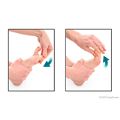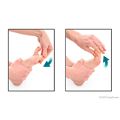Self-Care
There are many methods you can try to relieve the heel pain of plantar fasciitis. Different people find that one method or a combination of methods works best for them. Try the following methods.
- Rest your feet.
Stop or reduce any activities that may be causing your heel pain.
- Wear supportive footwear.
Wear shoes that have good arch support and heel cushioning.
- Buy shoe inserts (orthoticsorthotics).
Shoe inserts may be made of plastic, rubber, or felt. Orthotics can reduce stress and pulling on the plantar fascia ligamentplantar fascia ligament.
- Use ice on your heel.
Ice can help reduce inflammation. If ice isn't helping after 2 or 3 days, try heat, such as a heating pad set on low.
- Take a nonsteroidal anti-inflammatory drug (NSAID).
This medicine reduces pain and inflammation. Examples include ibuprofen (such as Advil or Motrin) and naproxen (such as Aleve). NSAIDs come in pills and in a cream that you rub over the sore area. Be safe with medicines. Read and follow all instructions on the label.
- Wear night splintsnight splints.
Night splints gently stretch the plantar fascia ligament and Achilles tendon and keep them from getting tight during the night.
- Do stretching and strengthening exercises.
Exercises for stretching the Achilles tendon and plantar fascia will increase their flexibility. Exercises to strengthen the muscles of the foot and ankle will help support the arch.
- Replace athletic shoes regularly.
Often athletes develop foot problems because they train in shoes that are worn out or don't fit properly. Replace your shoes every few months, because the padding wears out. Also, replace shoes if the tread or heels are worn down.
The healing process takes time—from a few months to a year. But you should begin to have less pain within weeks of starting treatment. If you have not improved after trying these methods for 6 weeks, your doctor may suggest other treatments.
To be successful at treating plantar fasciitis, you will need to:
- Be patient and consistent. The majority of cases of plantar fasciitis go away in time if you regularly stretch, wear good shoes, and rest your feet so they can heal.
- Start treatment right away. Don't just ignore the pain and hope it will go away. The longer you wait to begin treatment, the longer it will take for your feet to stop hurting.
Stretching your plantar fascia before you get out of bed
Many people with plantar fasciitis have intense heel pain when they take their first steps after resting for a long time. This pain comes from the tightening of the plantar fascia that happens during sleep. Stretching or massaging your plantar fascia before you stand up can often reduce heel pain.
- Stretch your foot by flexing it up and down 10 times before you stand up.
- Do toe stretchestoe stretches to stretch the plantar fascia.
- Use a towel to stretch the bottom of your foot (calf stretch with a towelcalf stretch with a towel).
Stretching exercises should create a pulling feeling. But they shouldn't cause pain. Ask your physical therapist or doctor which exercises will work best for you.
Learn more
- Orthotics for Foot ProblemsOrthotics for Foot Problems
- Plantar Fasciitis: ExercisesPlantar Fasciitis: Exercises
- Using Cold and Heat TherapiesUsing Cold and Heat Therapies













